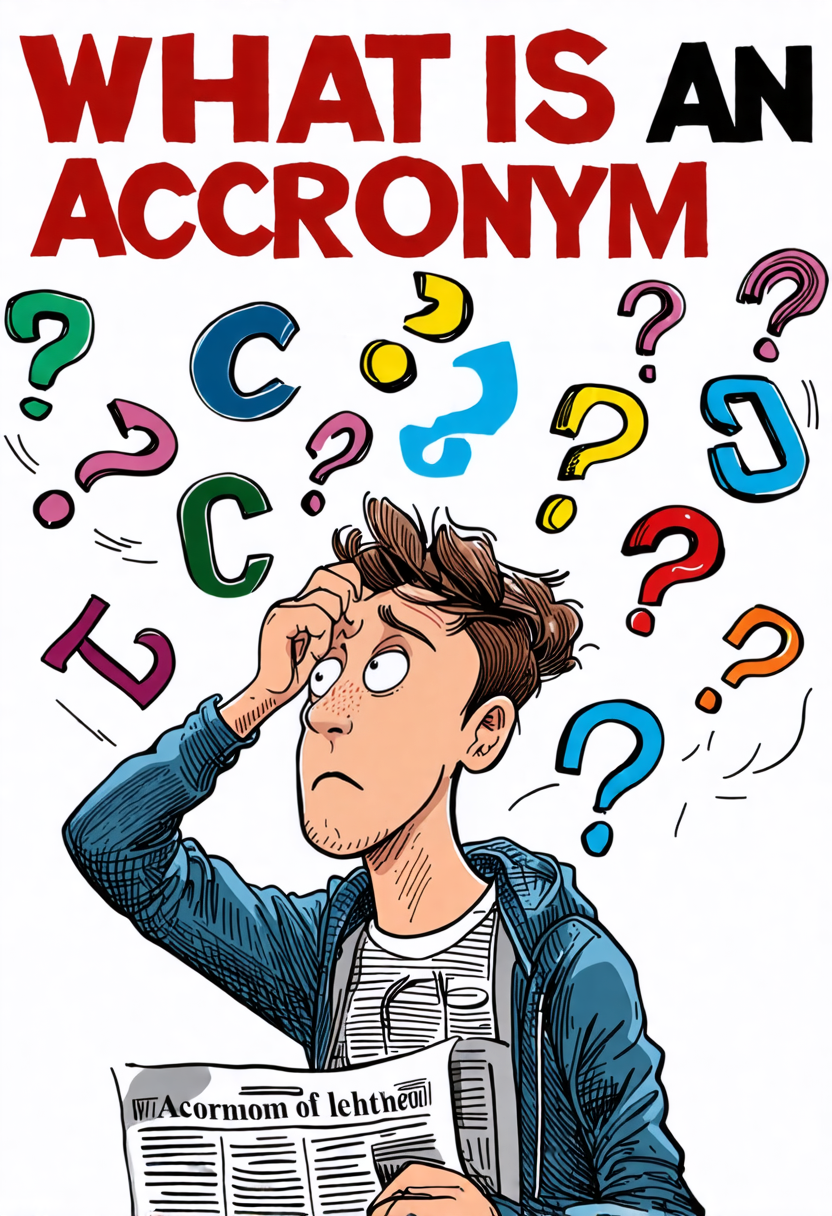What Is an Acronym?
An acronym is a word formed from the initial letters of a phrase, making it simpler and quicker to use. Unlike abbreviations, acronyms are pronounced as words. Common examples include NASA (National Aeronautics and Space Administration) and NATO (North Atlantic Treaty Organization).
Acronyms enhance communication efficiency by condensing lengthy phrases into memorable terms. They are widely used in various fields like business, technology, and medicine.
Acronym Definition
An acronym is a word formed by combining the initial letters or syllables of a phrase. This process creates a new term that is typically easier and quicker to use. For example, ‘radar’ comes from ‘radio detection and ranging.’ Acronyms are pronounced as words, unlike initialisms, where each letter is pronounced separately.
They often help in making communication concise and efficient. Acronyms are popular in both casual and professional contexts. They are frequently used in business communication, emails, and text messages to save time and space. Acronyms can also become brand names, adding to their versatility.
Examples of Acronyms
To illustrate the utility of acronyms, let’s explore some common examples. Acronyms are used in various fields and contexts to simplify communication. They are convenient for condensing long phrases into manageable terms.
Here are five widely recognized acronyms:
- NASA: National Aeronautics and Space Administration.
- UNICEF: United Nations International Children’s Emergency Fund.
- LASER: Light Amplification by Stimulated Emission of Radiation.
- PIN: Personal Identification Number.
- SCUBA: Self-Contained Underwater Breathing Apparatus.
Acronym Formation
Creating an acronym involves selecting the initial letters or syllables of a phrase to form a new, pronounceable word. This process starts with identifying a phrase that needs abbreviation.

Each significant word’s first letter or syllable is taken. For example, ‘National Aeronautics and Space Administration’ becomes NASA. Sometimes, syllables are combined, as in ‘radar’ from ‘radio detection and ranging.’
The goal is to create a word that is easy to remember and say. Acronyms can simplify complex terms, making them more accessible. They are commonly used in technology, science, and everyday language.
Pronunciation of Acronyms
How acronyms are pronounced often depends on whether they are spoken as a word or as individual letters. Acronyms like NASA and UNICEF are pronounced as whole words.
In contrast, initialisms such as FBI and ATM are spoken letter by letter. The choice of pronunciation can influence understanding and communication efficiency.
Whole Word Pronunciation: Acronyms that form pronounceable words.
Letter-by-Letter Pronunciation: Initialisms are spoken as individual letters.
Hybrid Forms: Some acronyms can be spoken either way, like ASAP.
Context Matters: Pronunciation may vary based on audience and setting.
Language Influence: Different languages may adapt pronunciations differently.
Acronyms in Communication
Acronyms play a significant role in enhancing communication efficiency in both written and verbal exchanges. They save time and space by condensing lengthy phrases into a single, easily recognizable word.
In everyday conversations, acronyms like ‘ASAP’ (as soon as possible) and ‘FOMO’ (fear of missing out) streamline dialogue and promote quick understanding.
In written communication, especially in emails and text messages, acronyms reduce the number of characters and make messages more concise. This is particularly useful in contexts with character limits, such as social media platforms.
Additionally, acronyms help in avoiding repetition of complex terms, making documents and conversations clearer and more straightforward.
Business Use of Acronyms
In the business world, acronyms are essential for streamlining communication and improving efficiency. They shorten lengthy phrases and make conversations quicker and clearer. Acronyms are widely used in emails, reports, and meetings to save time and space.
Key benefits of using acronyms in business include:
- Time Efficiency: Reduces the time needed to type or say phrases.
- Clarity: Simplifies complex terms and makes them easier to understand.
- Consistency: Standardizes language across teams and departments.
- Professionalism: Demonstrates industry knowledge and adherence to jargon.
- Memory Aid: Helps in remembering lengthy or complicated terms.
Acronyms in Branding
Brands often utilize acronyms to create memorable and easily recognizable names. This practice helps in establishing a strong brand identity. Acronyms simplify complex names and make them easier to remember and pronounce. This is particularly valuable in today’s fast-paced digital world where brevity is valued.
| Brand Name | Acronym Meaning |
|---|---|
| NASA | National Aeronautics and Space Administration |
| IKEA | Ingvar Kamprad Elmtaryd Agunnaryd |
| AT&T | American Telephone and Telegraph |
Acronym Vs. Initialism
Understanding the difference between an acronym and an initialism is essential for clear communication. An acronym forms a new word by combining the first letters or syllables of a phrase, such as ‘NASA’ for National Aeronautics and Space Administration. In contrast, an initialism spells out each letter individually, like ‘FBI’ for Federal Bureau of Investigation. This distinction helps avoid confusion in both written and spoken language.
- Pronunciation: Acronyms are pronounced as words, while initialisms spell out each letter.
- Examples: Acronym – NASA; Initialism – FBI.
- Usage: Acronyms are often used in casual speech; initialisms are common in formal contexts.
- Clarity: Knowing the difference aids in precise communication.
- Context: Acronyms and initialisms can serve different purposes depending on the setting.
Initialism Examples
While acronyms are pronounced as words, initialisms are pronounced by stating each letter individually. Initialisms are common in both casual and professional communication. They help to save time and space.
Here are some typical initialisms:
| Initialism | Meaning |
|---|---|
| FBI | Federal Bureau of Investigation |
| URL | Uniform Resource Locator |
| ATM | Automated Teller Machine |
Acronym Vs. Abbreviation
Acronyms and abbreviations both shorten phrases, but they do so in different ways. Acronyms create a new word from the first letters or syllables of a phrase, such as NASA or radar. Abbreviations, however, shorten words or phrases without necessarily forming a new word, like Dr. for Doctor.
Acronyms are pronounced as words, e.g., NATO.
Initialisms consist of each letter being pronounced, e.g., FBI.
Abbreviations are shortened forms of words, e.g., Mr., St.
Usage of acronyms often simplifies communication in professional and casual contexts.
Clarity can be an issue with acronyms, as they can sometimes be confused or unfamiliar, while abbreviations tend to be more straightforward.







